Porcelain Insulator News
by Elton Gish, NIA #41
Reprinted from "Crown Jewels of the Wire", April 1991, page 7
Barry Conolly recently made a nice find in Vermont. In an abandoned
substation at a marble quarry, he found two steel plates mounted on the inside
wall. Each plate had two (unmarked Thomas) M-3740's bolted on them! The glaze on
the top skirts were mottled tans. Below are a couple of photos that Barry took.
The steel plates had a small tag attached which described the assembly as a
choke coil arrangement manufactured by General Electric. The electrical rating
was 45,000 volts and 200 amps.
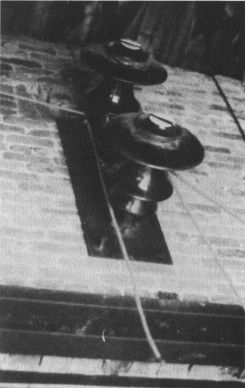
Barry has written an excellent article about his
exploits to this marble quarry to retrieve the M-3740's as well as some other
goodies. His article appears in this issue of "Crown Jewels". (See page
13) We need more articles of this type. Most of us will never have the
opportunity to experience finding insulators in the field. Why not consider
sending in one or more of your stories!! Even if you do not have photographs, we
would all like to hear about your experiences.
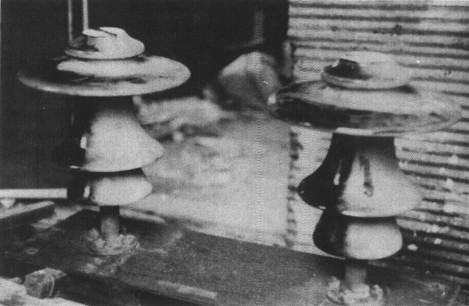
If you will check back to July, 1988, were ported a turquoise blue M-2636.
Actually, only three of these have been reported -- until now. Tim Wood of
Scio, Oregon has reported a fourth M-2636! This is perhaps the prettiest
multipart insulator known. But, guess some of you may disagree. That pretty
butterscotch tan glaze on early lily-shell styles is certainly nice, too. I do
wish that we could print a photo one of these in color. I have tried a couple of
times to reproduce the turquoise color on film, but without success. Even Tim's
photo showed the glaze to be closer to grey. There is something very odd about
that shade of blue.
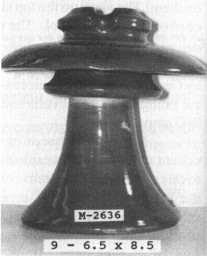
All four turquoise blue M-2636's have come from the
northwest. Perhaps there was only one line of these. The M-2636's have spiraling
machine marks inside the bottom shell which is indicative of Lima manufacture.
Albeit Tim will never give up trying to pry this jewel away from its owner.
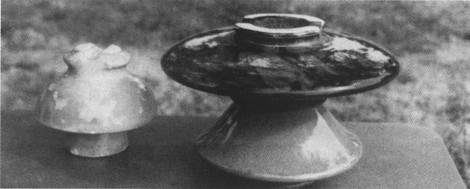
Tim
also reported several other goodies. As you can see in the photo (above) on this page, he has an Ohio Brass M-2926A. This is a beautiful
insulator in color. The top skirt is the typical O-B mottled black and tan, but
the bottom section is a contrasting reddish-tan! The small one in the photo is
an unmarked Fred Locke U-964.
Tim's last photo (below) is a real nice M-3725
manufactured by Fred Locke. Notice the nice shiny, mottled light tan glaze.
These insulators are found with Fred Locke's 7-patent date marking (7-1). They
were manufactured between June, 1902 and late 1903. Recent reports indicate that
these old jewels are still serving northern California, but there aren't many
left. They are very fragile and the porcelain is quite poor, too. I got one of
these back about 1974. It unfortunately arrived with the top skirt broken. I
would love to replace it with a very near mint specimen.
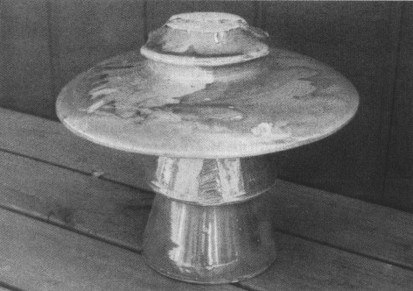
Tim states that this M-3725 came from Mexico. That is a long way to carry
this fragile jewel back to Oregon, but Mexico is a very good possibility. A line
of these insulators was installed by the Guanajuato Power and Electric Co. The
60 Kv line was put into service in October, 1903. It ran 101 miles from Zamora,
Mexico to Guanajuato, Mexico. (See the photo below -- from Electrical World
and Engineer, August 20, 1904)
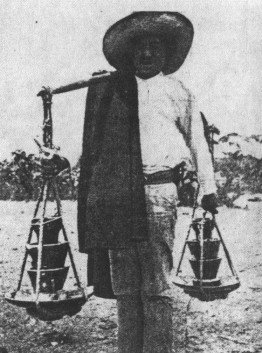
Looking through my research files, I find one other line that used M-3725's.
The Washington Water Power Co. installed a line in 1903 from Coeur d'Alene,
Idaho. I do not know where the line went.
The California line was owned by the
Bay Counties Power Co. If you will remember the PIN article in the September,
1990 issue of "Crown Jewels", that line was originally installed with
M-2795's (Fred Locke's multi-part with a top porcelain shell and a bottom glass
shell). The line ran from Colgate, California on the Yuba river to Oakland,
California -- a distance of 222 miles. Many of the M-2795's proved to be
incapable of withstanding 60 Kv, so the line was reinsulated in 1904 with
M-3725's and M-4325's, all made by Locke.
The last three photos were taken from
the Electrical Review dated August 15, 1900. The first photo (Fig. 2) shows a
pile of 20,000 top porcelain shells for M-2795. The top shells are piled outside
the Fred Locke porcelain factory and are waiting to be packed in the wooden
barrels shown in the left background. This is a classic photograph many of you
have either seen or heard about, but never have seen published.
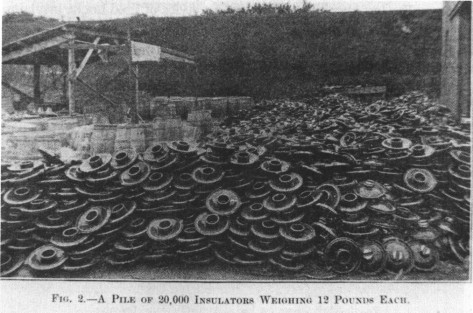
The next photo (Fig. 4) shows several M-2795's being subjected to an
electrical test. Notice the top porcelain shells in the foreground. The
completed units, with glass bases, are shown upside-down on the testing rack.
For testing, the glass bases were not cemented in the top porcelain shells. The
individual parts were shipped separately, assembled in the field, and cemented
with a mixture of sulfur and sand. The testing of insulators without cement was
an inadequate method of finding defective insulators. This practice was stopped
a few years later in favor of testing and shipping completed insulators from the
factory. More reliable insulators could be produced by curing the cement under
controlled temperature and humidity, then testing assembled units.
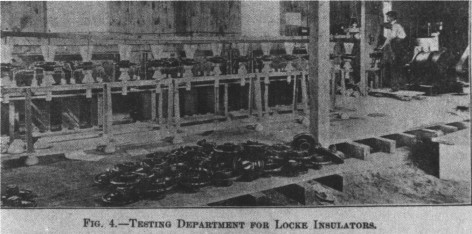
The last photo (Fig. 3) shows six styles of Fred Locke insulators from his
line of 20 styles of "Victor" insulators. The insulator on the far right is
M-2795, and the one on the far left is the 2-spout, M-2335. The two on the left
have porcelain bottom shells and the four on the right have glass bottom shells.
No specimens of 2, 3, 4, or 5 have been found. The porcelain top shell on the
fourth one from the left appears to be the top shell used on M-2332.
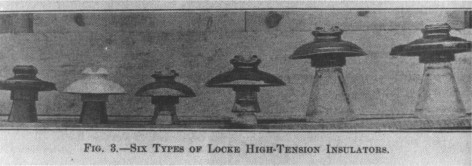
The "Victor" line of 20 styles was composed of various top shells
offered with either a porcelain or glass bottom shell. A list of these styles
was found in Fred Lockes 1900 and 1902 catalogs. The last two styles were added
for the 1902 catalog making a total of 22 styles. This list, with an additional
column showing the M-number is shown on the next page. Most of these have not
been found (and may never have been produced), so M-numbers were not assigned.
Note that the M-numbers are from my 1988 book, Multipart Porcelain
Insulators.
|
"VICTOR" INSULATOR LINE
from 1900 and 1902 Fred Locke catalogs
|
|
M-Number
|
Catalog
Number
|
Diameter |
Working Voltage |
Top Shell |
Base Part |
|
|
300
|
6-1/2" |
25,000 |
Eave |
Glass |
|
|
301
|
6-1/2" |
25,000 |
No Eave |
Glass |
|
|
302
|
6-1/2" |
25,000 |
Eave |
Porcelain |
|
|
303
|
6-1/2" |
25,000 |
No Eave |
Porcelain |
|
M-2336
|
304
|
7-1/2" |
40,000 |
Eave |
Glass |
|
|
305
|
7-1/2" |
40,000 |
No Eave |
Glass |
|
M-2335
|
306
|
7-1/2" |
40,000 |
Eave |
Porcelain |
|
M-2332
|
307
|
7-1/2" |
40,000 |
No Eave |
Porcelain |
|
|
308
|
8-1/2" |
47,000 |
Eave |
Glass |
|
|
309
|
8-1/2" |
47,000 |
No Eave |
Glass |
|
|
310
|
8-1/2" |
47,000 |
Eave |
Porcelain |
|
|
311
|
8-1/2" |
47,000 |
No Eave |
Porcelain |
|
|
312
|
9-1/2" |
52,000 |
Eave |
Glass |
|
|
313
|
9-1/2" |
52,000 |
No Eave |
Glass |
|
|
314
|
9-1/2" |
52,000 |
Eave |
Porcelain |
|
|
315
|
9-1/2" |
52,000 |
No Eave |
Porcelain |
|
M-2795
|
316
|
10-1/2" |
60,000 |
Eave |
Glass |
|
|
317
|
10-1/2" |
60,000 |
No Eave |
Glass |
|
M-2796
|
318
|
10-1/2" |
60,000 |
Eave |
Porcelain |
|
M-2842
|
319
|
10-1/2" |
60,000 |
No Eave |
Porcelain |
|
|
323
|
10-1/8" |
60,000 |
No Eave |
Porcelain |
|
327 |
14" |
80,000 |
No Eave |
Porcelain |
The 300 and 319 were first cataloged in 1900. The 323 and 327 were first cataloged in 1902. All types
shipped with loose base, cemented in the field. Type 327
had top part as 2-piece glazeweld into which the base
part was cemented. Many of these numbers were probably
never made. M-2795 is the most common style.
|
